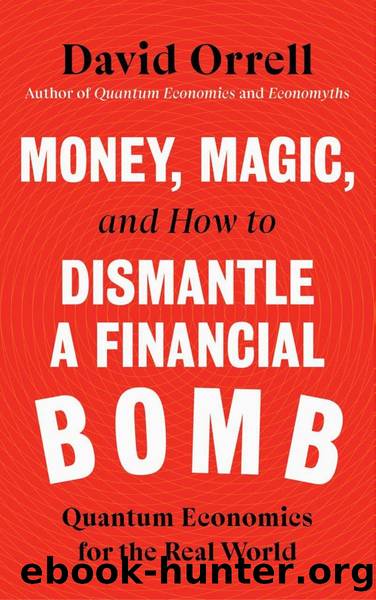Money, Magic, and How to Dismantle a Financial Bomb by David Orrell

Author:David Orrell
Language: eng
Format: epub
Publisher: Icon Books
Published: 2022-04-15T00:00:00+00:00
In 1947, two years after the Trinity test, the King of Denmark conferred on Niels Bohr the countryâs top honour (known as the Order of the Elephant, long story). The physicist needed a coat of arms to display at Frederiksborg Castle, and the design he chose featured a yin-yang symbol and a motto in Latin: contraria sunt complementa (opposites are complementary), which captured his principle of complementarity. This refers to the idea that quantum systems have complementary attributes, such as position and momentum, which cannot both be measured at the same time. In particular, quantum entities such as an electron have both wave and particle properties.
One can measure the location of an electron, as if it were a particle, but it also has a frequency, as if it were a wave. Neither description is complete in itself. An electron is singular and dissolved at the same time. The wave-like aspect is captured by something known as the Schrödinger wave equation. According to standard interpretations of quantum mechanics, the system prior to measurement is in a superposition of all the possible states. Only at the time of measurement does it somehow âcollapseâ down to a specific state. The amplitude of the wave function at each position, when squared (this again is the 2-norm of quantum probability), gives the probability that the electron will be detected at that point, but the state is uncertain until measured.
As with other waves, the wave function displays features such as interference. This was most famously illustrated by the double-slit experiment, which is one of the most magical experiments in physics.
Physicists had long debated whether light was a particle or a wave. In the fourth century BC, Democritus said that light was made up of discrete atomos, or atoms. Aristotle countered that it was a wave in the ether. In the seventeenth century, Newton saw it as a stream of particles, while physicists on the Continent preferred the wave option.
In 1801, Thomas Young performed an experiment in which light from a source passes through two slits in a screen. He found that the light diffracts at each slit and forms an interference pattern, which is picked up by detectors on a second screen. The appearance of this pattern seemed to prove that light was a wave.1 Waves have crests and troughs, so when two waves interfere with one another, there will be points where the crests reinforce one another, and other points where a trough is formed.
The debate, however, found new life when Einstein showed that light was a stream of photons. Finally, in 1909, Geoffrey Taylor repeated the experiment using an extremely weak light source, and demonstrated that even when individual photons are passed through the slit, the interference patterns are still reproduced.2 The crests correspond to places with a high probability of seeing a photon, while the troughs are places with a low probability. Even though individual photons only pass through a single slit, they somehow react to the presence of the other slit. However,
Download
This site does not store any files on its server. We only index and link to content provided by other sites. Please contact the content providers to delete copyright contents if any and email us, we'll remove relevant links or contents immediately.
Zero to IPO: Over $1 Trillion of Actionable Advice from the World's Most Successful Entrepreneurs by Frederic Kerrest(4064)
Machine Learning at Scale with H2O by Gregory Keys | David Whiting(3640)
Harry Potter and the Goblet Of Fire by J.K. Rowling(3612)
Never by Ken Follett(3533)
Ogilvy on Advertising by David Ogilvy(3338)
Shadow of Night by Deborah Harkness(3177)
The Man Who Died Twice by Richard Osman(2811)
Book of Life by Deborah Harkness(2721)
My Brilliant Friend by Elena Ferrante(2704)
How Proust Can Change Your Life by Alain De Botton(2615)
0041152001443424520 .pdf by Unknown(2599)
Will by Will Smith(2581)
The Tipping Point by Malcolm Gladwell(2562)
How to Pay Zero Taxes, 2018 by Jeff A. Schnepper(2503)
Purple Hibiscus by Chimamanda Ngozi Adichie(2492)
Hooked: A Dark, Contemporary Romance (Never After Series) by Emily McIntire(2423)
Rationality by Steven Pinker(2150)
Borders by unknow(2119)
Daughter of Smoke and Bone by Laini Taylor(2083)
